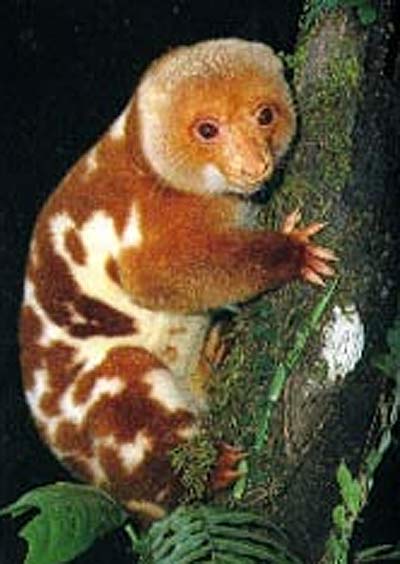The cuscus is a marsupial which is native to the Northern forest of Australia, the island of Papua New Guinea and on other nearby islands. The 23 species of cuscus differ in size, color, and habitat. Length can be from 14 to 16 inches long, and they can weigh between 3.3 to 13 pounds. Their incredibly long tails are from 13 to 24 inches.
With a rounded head, small ears, and large round eyes, this
arboreal (lives in treetops) animal has five strong opposable digits whose nails ensure
stability and a strong grip on the tree branches. The cuscus’s nails are also
used for grooming. The tail, which lacks
hair at the top, is both long and prehensile which helps to facilitate movement
throughout the trees functioning as another limb.
 |
| White Cuscus Photo: From The Featured Creature |
Biologist Muse Opiang holds a Bosavi silky cuscus, a newly
discovered marsupial from central Papua New Guinea, in early 2009.
 |
| Biologist Muse Opiang holds a Bosavi silky cuscus Photo: Kristofer Helgen |
While originally considered to be a close relative to the
monkey, the cuscus’s closest relative is actually the opossum. A nocturnal animal, the cuscus sleeps during the day in
dense vegetation and is very shy. Seeing one in the wild is a rare event.
 |
| Ground Cuscus Cotswold Wildlife Park, Burford, Oxforshire |
Being a marsupial, the undeveloped babies crawl into the
mother’s pouch after a couple of weeks to continue their development for six to
seven months. While the female will usually give birth to two to three babies,
usually only one baby survives.
 |
| Two-month old baby who ventured out of the pouch Photo: Twycross Zoo |
While
considered a newly discovered species, this shy, solitary animal is shown in a
drawing of the spotted cuscus on a page from The Royal Natural History, Volume
3, edited by Richard Lydekker, dating 1894-1895.
Would you like to see a spotted cuscus?
Sources:









